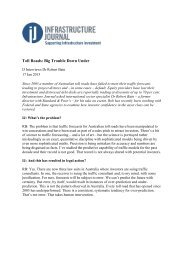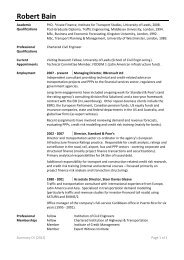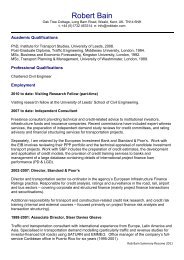Disincentivising overbidding for toll road concessions
Disincentivising overbidding for toll road concessions
Disincentivising overbidding for toll road concessions
- No tags were found...
Create successful ePaper yourself
Turn your PDF publications into a flip-book with our unique Google optimized e-Paper software.
3 │ TOLL ROAD CASE STUDIES<br />
and the consequent implications <strong>for</strong> VfM. All else equal, <strong>road</strong> projects that insulate lenders from traffic risk exposure<br />
attract more competitive financing (a b<strong>road</strong>er community of finance providers offering lower margins), irrespective<br />
of upside limitations. Indeed, much of the enthusiasm <strong>for</strong> availability-based payment mechanisms has come from<br />
the financial services sector (banks and financial advisers). While the financing environment cannot be ignored<br />
when shaping concession projects and associated transaction structures, the choice of payment mechanism should<br />
ultimately be derived from policy objectives, and not selected <strong>for</strong> the convenience of bankers.<br />
Many <strong>toll</strong> <strong>road</strong> <strong>concessions</strong> (recently awarded or currently in procurement) from around the world employ the<br />
availability-based model. These <strong>for</strong>ms of concession are still in a minority compared with the traditional user-pays<br />
model, however. Examples can be found in the USA (Port of Miami Tunnel); Spain (the del Oliviar motorway); Russia<br />
(the Eastern Bypass Road); the Netherlands (N33); Malaysia (the West Coast Expressway, which is part-<strong>toll</strong>ed, partavailability);<br />
Egypt (the Rod El Farag Access Road); Austria (the B4 Maissau Bypass); and Romania (a 46km package<br />
of highway improvements in Buzau in the eastern part of the country). The Peninsula Link project in Victoria, Australia,<br />
has also embraced the availability-based payment philosophy.<br />
The UK PPP <strong>road</strong>s sector represents an interesting case study in this regard—partly because of the role of availability<br />
payments alongside (blended with) other reimbursement criteria; and partly because of the evolution of mechanisms<br />
employed by the concession grantor, the UK Highways Agency. This is summarised in Box 3.1.<br />
Box 3.1 UK PPP <strong>road</strong>s: the rise and fall of availability-based payment mechanisms<br />
The first generation of PPP <strong>road</strong>s in the UK employed availability payments in a relatively minor role, primarily<br />
incentivising concessionaires to complete construction works on or ahead of time. The principal reimbursement<br />
metric involved shadow <strong>toll</strong>s 82 —payments made by the state <strong>for</strong> asset usage through ‘traffic bands’. Bidders<br />
specified bands that would attract different reimbursement amounts, <strong>for</strong> example:<br />
••<br />
Band 1: 9 pence/vehicle-km <strong>for</strong> the first 70m vehicle-km/year;<br />
••<br />
Band 2: 6 pence/vehicle-km <strong>for</strong> the next 30m vehicle km/year;<br />
••<br />
Band 3: 3 pence/vehicle-km <strong>for</strong> the next 30m vehicle km/year;<br />
••<br />
Band 4: zero pence/vehicle-km thereafter (capping the Highways Agency’s obligations).<br />
The payment mechanism drew a distinction between light and heavy vehicles (based on length), with heavy<br />
vehicle usage attracting higher reimbursement.<br />
Shadow <strong>toll</strong>s pass traffic risk to the concessionaire; however, with the use of traffic bands, some of this risk is<br />
shared with the concession grantor. As the lower levels of traffic usage (about which there is more certainty)<br />
attract the larger reimbursement payments in terms of pence/km, capital structures could respond accordingly<br />
(senior debt being sized against Band 1 revenues, <strong>for</strong> example). 83<br />
Beyond estuarial crossings, user <strong>toll</strong>s are relatively uncommon in the UK. All of the early PPP <strong>road</strong>s—and still the<br />
majority today—are <strong>toll</strong>-free, with the state (not users) reimbursing the concessionaire.<br />
In addition to shadow <strong>toll</strong>s and a service availability component, the first-generation payment mechanisms<br />
incorporated per<strong>for</strong>mance-related criteria (deductions stemming from lane closure charges and bonus payments<br />
<strong>for</strong> safety improvements).<br />
In the second-generation model, the influence of shadow <strong>toll</strong>s was reduced and availability-based payments<br />
became the dominant component. Shadow <strong>toll</strong>s were linked to heavy vehicles only and the concept of availability<br />
was extended beyond the project <strong>road</strong> itself to cover attendant infrastructure (footpaths, cycle ways, etc). The<br />
definition of availability was also b<strong>road</strong>ened to reflect the condition of the <strong>road</strong> and was fine-tuned to incentivise<br />
the operator to keep the <strong>road</strong> fully operational during predetermined (mainly peak) periods.<br />
(continued)<br />
82 User <strong>toll</strong>s are not collected under a shadow <strong>toll</strong>ing regime. Instead, the concession grantor makes payments—typically, a fee per vehicle—to the<br />
<strong>road</strong> concessionaire based on asset usage. The UK developed shadow <strong>toll</strong>s in response to early political concerns about the public acceptability<br />
of <strong>toll</strong>s (particularly on upgraded, as opposed to new, <strong>road</strong>s) and concerns about the impact of <strong>toll</strong>ing in terms of traffic diversion to less suitable<br />
routes.<br />
83 For a full description, see Bain, R. and Wilkins, M. (2003), ‘The Evolution of DBFO Payment Mechanisms: One More <strong>for</strong> the Road’, Standard &<br />
Poor’s, London, March.<br />
31






